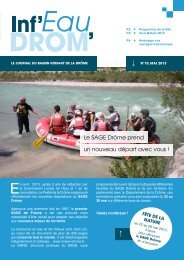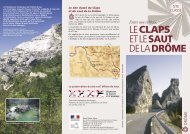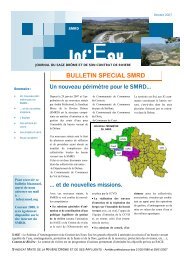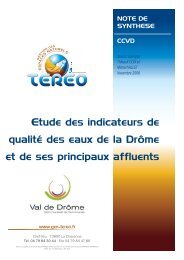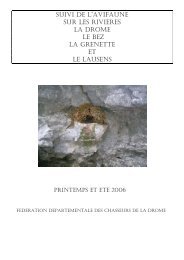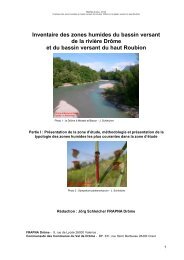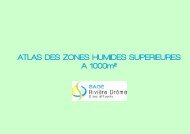Rapport final V5 - Syndicat Mixte de la Rivière Drôme
Rapport final V5 - Syndicat Mixte de la Rivière Drôme
Rapport final V5 - Syndicat Mixte de la Rivière Drôme
- No tags were found...
Create successful ePaper yourself
Turn your PDF publications into a flip-book with our unique Google optimized e-Paper software.
SOMMAIRE1 INTRODUCTION ....................................................................................................................................... 61.1 GENERALITES SUR LE SAGE ET OBSERVATOIRE DE LA RIVIERE DROME.............................................. 61.2 CARACTERISTIQUES DE LA ZONE D’ETUDE............................................................................................ 71.2.1 La <strong>Drôme</strong> ........................................................................................................................................ 81.2.1.1 Climat.................................................................................................................................................... 81.2.1.2 Géologie ................................................................................................................................................ 81.2.1.3 Hydrologie............................................................................................................................................. 91.2.2 Le Roubion ...................................................................................................................................... 91.2.2.1 Géologie ................................................................................................................................................ 91.2.2.2 Hydrologie............................................................................................................................................. 92 BIOLOGIE ET ECOLOGIE DES ESPECES ........................................................................................ 112.1 L’ANGUILLE (ANGUILLA ANGUILLA).................................................................................................. 112.2 L’ECREVISSE A PATTES BLANCHES (AUTROPOTAMOBIUS PALLIPES)................................................... 132.3 LE BARBEAU MERIDIONAL (BARBUS MERIDIONALIS).......................................................................... 152.4 LA TRUITE FARIO (SALMO TRUTTA FARIO).......................................................................................... 163 METHODOLOGIE................................................................................................................................... 183.1 PRESENTATION DE LA DEMARCHE....................................................................................................... 183.2 DONNEES BIOLOGIQUES...................................................................................................................... 183.2.1 Données actuelles.......................................................................................................................... 183.2.1.1 Pêches électriques................................................................................................................................ 183.2.1.2 Observations directes .......................................................................................................................... 203.2.2 Données historiques ...................................................................................................................... 213.3 DONNEES ENVIRONNEMENTALES........................................................................................................ 223.3.1 Caractéristiques naturelles ........................................................................................................... 223.3.2 Facteurs anthropiques................................................................................................................... 223.3.2.1 P<strong>la</strong>n Départemental pour <strong>la</strong> Protection du milieu aquatique et <strong>la</strong> Gestion <strong>de</strong>s Ressources piscicoles(P.D.P.G.) <strong>de</strong> <strong>la</strong> <strong>Drôme</strong> ............................................................................................................................................ 223.3.2.2 Réseau d’Observation <strong>de</strong>s Milieux (ROM) ......................................................................................... 233.3.2.3 Qualité <strong>de</strong> l’eau ................................................................................................................................... 233.4 ANALYSES DES DONNEES.................................................................................................................... 233.4.1 Cartographie................................................................................................................................. 233.4.2 Typologie....................................................................................................................................... 243.4.3 Comparaison entre observations actuelles observées et référentiels théoriques .......................... 253.4.4 Variabilité temporelle ................................................................................................................... 253.4.5 Diagnostic ..................................................................................................................................... 264 RESULTATS ............................................................................................................................................. 274.1 DESCRIPTION DES DONNEES RASSEMBLEES......................................................................................... 274.1.1 Base <strong>de</strong> données «Pêche électrique»............................................................................................. 274.1.1.1 Caractéristiques générales ................................................................................................................... 274.1.1.2 Représentativité................................................................................................................................... 274.1.2 Base <strong>de</strong> données «prospections écrevisse» ................................................................................... 284.2 ANALYSE CARTOGRAPHIQUE DE LA REPARTITION DES ESPECES.......................................................... 294.2.1 L’anguille (Anguil<strong>la</strong> anguil<strong>la</strong>)....................................................................................................... 304.2.1.1 Répartition générale ............................................................................................................................ 304.2.1.2 Analyse par contexte ........................................................................................................................... 334.2.2 Le barbeau méridional (Barbus meridionalis).............................................................................. 384.2.2.1 Répartition générale ............................................................................................................................ 384.2.2.2 Analyse par contexte ........................................................................................................................... 424.2.3 L’écrevisse à pieds b<strong>la</strong>ncs (Austropotamobius pallipes)............................................................... 484.2.3.1 Répartition générale ............................................................................................................................ 484.2.3.2 Analyse par contexte ........................................................................................................................... 524.2.4 La truite fario (Salmo trutta fario) ................................................................................................ 584.2.4.1 Répartition générale ............................................................................................................................ 584.2.4.2 Analyse par contexte ........................................................................................................................... 614.3 ANALYSE TYPOLOGIQUE..................................................................................................................... 684.3.1 Typologie <strong>de</strong>s stations par espèce................................................................................................. 683



